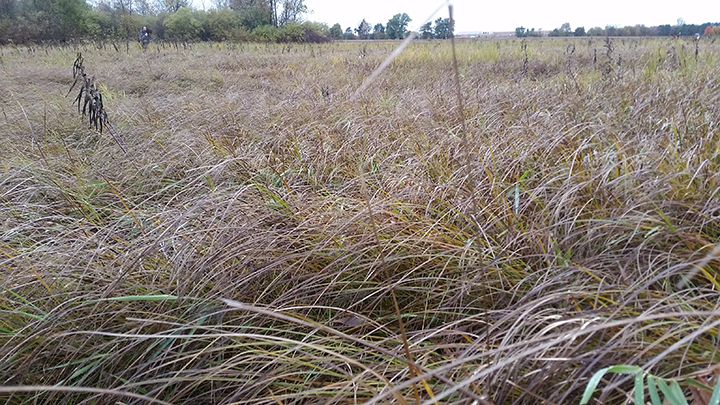In terms of prairies, and plant life in general, October is the month that separates the cool season plants from the warm season.
Warm season plants are those that thrive in the warmer temperatures of summer, but begin to go dormant when the cool days and nights of autumn arrive. The cool season plants are those that thrive in spring and fall. October is the month that separates the sheep from the goats, as it were, like no other month [the metaphor has its limitations as in the biblical account (Mathew 25:31-46) judgment is rendered on the goats, who will not enter the kingdom of heaven, whereas the sheep do].
Here are some examples we’re seeing these days:
The Asters, native wildflowers, are perhaps the coolest of the cool season natives. They are the last of the wildflowers to bloom, and do so in September and October. Without them, the prairies would go dormant and lose their color somewhat earlier, perhaps ending on a Goldenrod note.
This is a sedge meadow that we walked through yesterday to check where the firebreaks would go for a future burn. The sedges (a native wetland plant) have gone dormant, with the exception of some cordgrass in the middle. But note the Reed Canary grass in the lower right part of the screen. It is thriving in the cool temps of mid-October. Reed Canary grass, an invasive species, is definitely a cool season grass.
Here we see the Reed Canary grass again, quite active, in front of a Buckthorn shrub in the woods. Its dense, green color suggests that is is very active right now. Its activity is not directed toward growth, but toward storing nutrients for the winter. It is not putting out new foliage, but rather gathering carbon from the air and soil and storing it as sugar so that it not only survives the winter, but gets a jump in spring. Hence the success of this invasive, non-native shrub, Buckthorn.
There’s the dreaded Reed Canary grass again, still green on the roadside, whereas the corn, perhaps the quintessential warm season plant (originated the the warm climate of Central America), has been dormant for some time now.
Here, in the foreground, is a remnant of native Switchgrass which is pretty much dormant, though some of the Bromegrass around it is still active. The alfalfa in the background is very much a cool season plant. It is thriving in this these 40-degree, wet conditions.
The turf grass, in this case, Fescue, is also thriving in these cool temperatures. This is why it is said that fall is a good time to fertilize your lawn, as the active plant takes in the nutrients. The prairie behind it is pretty much shut down, except for the odd goldenrod here and there.
Knowledge of cool season versus warm season plants is very important for prairie restorationists in particular, and anyone who deals with plants in general. This is because knowing the activity of a plant can help one decide when to apply fertilizers or herbicides, or indeed when to plant.
For example, October is the month that we’re out spot spraying Reed Canary grass in prairies. We spray now because the natives are shutting down and are not affected by the herbicide, whereas the cool season non-natives take in the herbicide.
Another example is lawn seeding. As said before, bluegrass and fescue, both lawn turf grasses, are cool season plants. So by seeding them in September, one can do so without extra watering, partly because the sun is low, and the moisture stays in the soil. The upshot is that, by seeding in the fall, one need not purchase and install a sprinkler system. The grass will come up on its own quite well.
Of course some grasses do better with less water in the long term than others (such as fescues, as opposed to Bluegrass), so thought needs to be put into that.
This is an area on our farm that I seeded toward the end of September some years ago. This is a large area and we had no intention of installing a sprinkler system. We seeded it in a fescue mix, which is a grass that grows slowly, crowds out the weeds better than Bluegrass, and, once established, does not need to be watered.
Here is the same area, probably photographed in October that same year. One sees the grass coming up on its own. It should also be said that the weeds are not germinating in the fall, and so very few weeds came up in this seeding.
Here is a photo taken the following spring, probably after I fertilized it, which I did only once (the fescue does well on its own in time, and does not need fertilizing in the long term).
Paying attention to cool season and warm season plants is not only interesting, but can make the difference between installing a $5,000 irrigation system, and not installing one at all.









